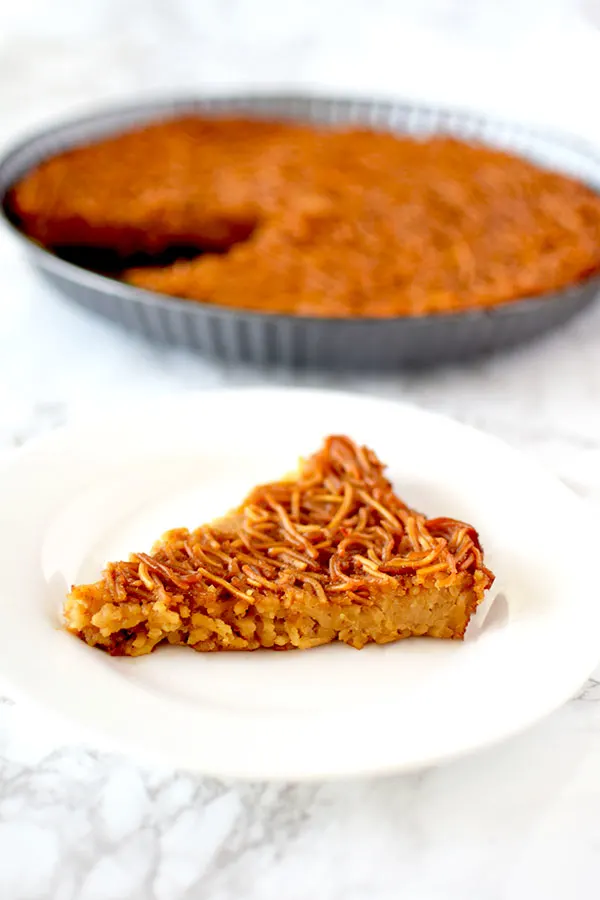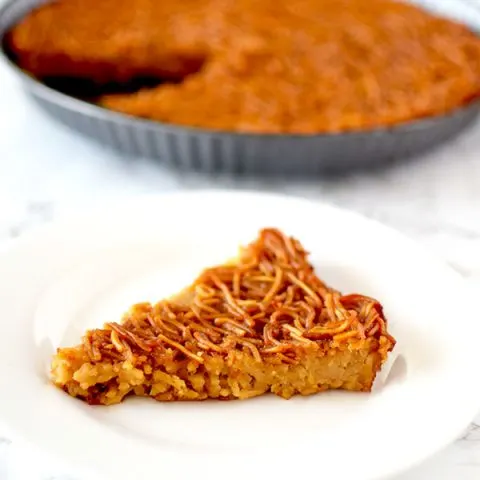Yerushalmi kugel, also known as Jerusalem kugel, is a classic Israeli Shabbos dish. It is noodle pudding made with caramelized sugar and seasoned with black pepper, making it both sweet and spicy.

Yerushalmi kugel is a very popular Israeli Shabbos dish.
This noodle kugel originated in Jerusalem in the late 19th century, but nowadays you can find it anywhere in the country.
It is not uncommon to see it sold Friday mornings in Israeli bakeries along side rugelach, babka, and other goodies.
Like other kugels, Yerushalmi kugel is typically served Shabbos or holiday mornings at kiddushes.
It’s often found on family tables and I’ve never been to an Israeli community kiddush where there weren’t plates of it.
To be honest, I am not much of a kugel fan, but I love Yerushalmi kugel!
It has been my favorite kiddush food since I was a child; and now as an adult, it takes all my willpower to only eat one or two pieces.
I just love the caramel sweetness and the spiciness brought by the pepper.
What are other kugels I can serve with this?
Potato is the next most popular in Israel, but I am partial to my mom's broccoli kugel. Noodle kugel is also always nice though it is usually made for Shavuot.
Can I use other noodles?
Yes. It is becoming increasingly popular to make these with spaghetti.
Sugar
The primary role of sugar is to be a sweetener. However, sugar also contributes to the tenderness and moistness of the baked good by absorbing and retaining moisture and helps create the golden brown color when baking as it caramelizes.
Recipes with more sugar often result in softer, moister textures. However, I learned the hard way that too much sugar leads to a sticky mess.
When it's heated, sugar caramelizes, resulting in a rich, complex flavor and a brown color. This adds both flavor and color to baked goods and is also the process in which caramel sauce, dulce de leche, caramel candies, and regular candies are made.
When used in recipes containing yeast, the sugar is eaten by the yeast, producing carbon dioxide and causing the dough to rise.
Sugar also acts as a preservative in jams, jellies, and fruit preserves by reducing water activity and preventing microbial growth.
There are many different types of sugar, including white sugar, brown sugar, vanilla sugar, powdered sugar, turbinado sugar, and demerara sugar.
When a recipe calls for “sugar” without specifying anything else, it's referring to regular white sugar.
White Sugar
White sugar (sometimes called granulated sugar, table sugar, or white granulated sugar) is made of either beet sugar or cane sugar, which has undergone a refining process.
It is the easiest to find and most commonly used.
Brown Sugar
Brown sugar is white sugar with molasses added to it.
It is commonly used in chocolate chip cookie recipes, and it’s rare for a recipe that calls for brown sugar not to also call for white sugar as well.
When a recipe calls for “brown sugar” but doesn’t specify what type (light or dark), it is referring to light brown sugar.
In my recipes, you can use whatever type of brown sugar you have on hand, whether it is dark brown sugar, light brown sugar, or demerara sugar - which is very common in Israel.
Just keep in mind that the flavor and color will be slightly different, depending on what you choose to use.
Turbinado Sugar
Turbinado sugar is better known as "raw sugar." But, despite this name, the sugar is not really “raw.”
Instead, it's partially refined sugar that retains some of the original molasses.
The term "raw sugar" may also give off the impression that it is somehow healthier.
In reality, turbinado sugar is nutritionally similar to white sugar.
Demerara Sugar
Demerara sugar is very popular in Israel and is especially delicious in tea, but is also used for baking.
Unlike white sugar, demerara sugar undergoes minimal processing and retains some vitamins and minerals.
However, it is still not much healthier than white sugar.
Vanilla Sugar
Vanilla sugar is not very common in the States. However, it is common in Israel and parts of Europe.
This is sugar that sat for an extended period of time with vanilla beans, giving it a vanilla flavor.
Caster Sugar
This type of sugar is common in the United Kingdom.
It has a grain finer than white (granulated) sugar and larger than powdered sugar.
Caster sugar is often called for in recipes for delicate baked goods like meringues, souffles, and sponge cakes.
You can use a 1:1 conversion rate between caster sugar and white (granulated) sugar.
Powdered sugar
Powdered sugar, sometimes known as confectioners’ sugar, is a sugar with a powdered texture.
This sugar is rarely used for baking. Instead, it is used for dusting desserts and making frosting, icing, and glazes.
In some countries, you can also find powdered vanilla sugar.
It is made the exact same way regular vanilla sugar is made. However, the sugar used is powdered instead of granulated.
Vanilla Extract vs Vanilla sugar
In my recipes, I don’t specify what kind of vanilla to use.
The reason for this is that in the States, vanilla extract is exclusively used.
Meanwhile in Israel, along with many European countries, vanilla sugar is common.
In most, if not all recipes, both vanilla extract and vanilla sugar can be used.
In recipes where vanilla sugar can be used instead of extract, you can replace them 1:1.
Replacing Sugar with Honey
If you’d prefer to use honey instead of sugar, you can do so with pretty good results.
Honey can be two or even three times as sweet depending on the honey, so for every 1 cup of sugar, you can use ½ to ⅔ cup honey.
Since honey adds liquid, you need to remove some to balance it out. For every cup of honey, remove a ¼ cup of liquid.
Also, it burns faster than granulated sugar, so you want to lower the baking temperature by 25 F. In addition, check it early and often to avoid burning or overbaking.
How to Store Sugar
Sugar should be stored in an airtight container to prevent clumping and moisture absorption, and kept in a cool, dry place.
Adjusting for a Convection Oven
Convection ovens blow the hot air around, producing around 25 to 30 percent more heat.
Since convection ovens produce more heat, you need either lowering the temperature or shortening the cooking time to compensate.
When recipes specify temperatures and cooking times, it’s for conventional ovens, unless specified otherwise.
A simple rule to follow is to lower the temperature by 25ºF or 14ºC when baking cookies and pies, and 50ºF or 28ºC when roasting meat and poultry. Some convection ovens offer separate settings for baking and for roasting.
You can also leave the temperature the same and instead, shorten the cooking time by 25 percent. For example, if your recipe calls for 60 minutes in the oven, check the food after 45 minutes instead.
However, keep in mind, some convection ovens actually make a heat adjustment for you. That is, if you set a convection oven for 350ºF, it might actually set itself to 325ºF to compensate. So, check your manual before making adjustments.
How to Store
Let cool completely. Wrap with plastic wrap or foil, or place in an airtight container or resealable plastic bag. Refrigerate for 3 to 5 days.
TROUBLESHOOTING
WHY IS IT TAKING LONGER THAN DESCRIBED TO BAKE?
Over time, the thermostat on ovens gets a little off, causing some ovens to run hot and others to run cool. This is why recipes tend to say things like “10 to 15 minutes or until golden brown.” So, if it takes you longer than expected that’s fine, don’t worry about it. Just keep baking until ready.
WHY DID MY RECIPE COME OUT TOO DRY?
Just like some ovens run cool, others run hot. If your oven runs hot, bake these at a lower temperature. Ideally, you should get an oven thermometer to know what temperature you’re really baking at.
Recipe Tip:
Do not use cool or mushy noodles, it will make this recipe much harder to make.
Yerushalmi Kugel

This authentic Israeli Yerushalmi Kugel is like the average Israeli, both sweet and spicy.
Ingredients
- 1 pound egg noodles, short and thin (450 grams)*
- ¼ cup oil (60 milliliters)
- 1 ½ cup white sugar (300 grams)
- 4 eggs, beaten
- 1 tablespoon salt
- 1 to 3 teaspoons black pepper
Instructions
- Cook noodles as directed on the package. Strain the water.
- Heat the oil in a heavy bottom pan over a medium high flame. When hot, add 1 cup of sugar and stir continuously until fully caramelized.
- Slowly add the noodles to the caramel a spoonful at a time, mixing each one in as you go.
- Mix in eggs, the remaining ½ cup sugar, salt, and black pepper. Mix well.
- Preheat oven to 350°F or 175°C. Pour into a round or rectangular pan,
- Bake for about 2 hours or until brown.
Notes
*if you don't have have these noodles, you can make it with spaghetti, which seems to be an increasingly popular choice in Israel
Nutrition Information:
Yield:
8Serving Size:
1Amount Per Serving: Calories: 230Total Fat: 11gSaturated Fat: 2gTrans Fat: 0gUnsaturated Fat: 8gCholesterol: 109mgSodium: 832mgCarbohydrates: 28gFiber: 1gSugar: 13gProtein: 6g
Friday 7th of February 2020
i love this recipe!!!! i use 11/2 tsp pepper and its perfect thank you!!!
ElissaBeth
Friday 7th of February 2020
Happy to hear it! Thanks for sharing ☺️
Minna Lederberger
Sunday 8th of September 2019
I wouldn't change it. True Yerushalmi kugel needs the pepper and I often use 2 TBSP. Pepper I find that most recipes have too little. It's refreshing to find one that has the correct amoutn.
ElissaBeth
Monday 9th of September 2019
Thank you Minna :)
Sue
Wednesday 22nd of May 2019
Hi, Tried this kugel as I was really looking forward to it since it seemed simple and who doesn't love that?! But I believe there is a mistake in the ingredients. 1-3 Tablespoon pepper??? I only put one Tablespoom in and it was so peppery, unfortunately I had to throw it out. I will definitely try again with less pepper.
ElissaBeth
Wednesday 22nd of May 2019
Hi Sue. I'm sorry that you found it too peppery. As explained in the post itself, this is a very sweet and peppery recipe. A good Jerusalem kugel has a lot of pepper. Since it's a Middle Eastern dish my guess is that it's made for people who can handle a high level spiciness. However, based on your experience I am changing it from tablespoons to teaspoons :) Thanks for the feedback!